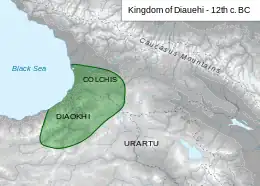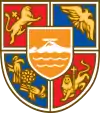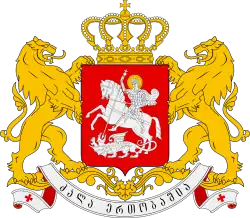Diauehi დიაოხი Diaokhi[1] | |
|---|---|
| 12th century BC [a][2][3][4]–8th century BCE | |
 | |
| Capital | Zua |
| Largest city | Zua, Shashilu, Utu |
| Common languages | Armenian language Kartvelian languages[5] Hurrian language |
| Religion | Zoroastrianism |
| King | |
• Approx. BC 1120 - BC 1100 | Sien |
• Approx. BC 850 - BC 825 | Asia |
• Approx. BC 810 - BC 770 | Utupursi (last) |
| History | |
• Established | 12th century BC [a][6][7][8] |
| 8th century BCE | |
• Disestablished | 8th century BCE |
| Today part of | Georgia[14] Turkey |
| History of Armenia |
|---|
 Coat of Arms of Armenia |
| Timeline • Origins • Etymology |
| Part of a series on the |
| History of Georgia |
|---|
.jpg.webp) |
Diauehi (Georgian დიაოხი, Urartian Diauehi, Greek Taochoi, Armenian Tayk, possibly Assyrian Daiaeni) was a tribal union located in northeastern Anatolia, that was recorded in Assyrian and Urartian sources during the Iron Age.[15] It is usually (though not always) identified with the earlier Daiaeni (Dayaeni),[16] attested in the Yonjalu inscription of the Assyrian king Tiglath-Pileser I's third year (1118 BC) and in later records by Shalmaneser III (845 BC). While it is unknown what language(s) they spoke,[17]: 205 they may have been speakers of a Kartvelian,[18][19][20][21][15][22][23][24][25] Armenian,[26][27][28] or Hurrian language.[29][30][31][32][33]
Location
Although the exact geographic extent of Diauehi is still unclear, many scholars place it in the Pasinler Plain in today's northeastern Turkey, while others locate it in the Armenian–Georgian marchlands as it follows the Kura River. Most probably, the core of the Diauehi lands may have extended from the headwaters of the Euphrates into the river valleys of Çoruh[34] to Oltu. The Urartian sources speak of Diauehi's three key cities—Zua, Utu and Sasilu; Zua is frequently identified with Zivin Kale and Utu is probably modern Oltu, while Sasilu is sometimes linked to the early medieval Georgian toponym Sasire, near Tortomi (present-day Tortum, Turkey).[35] The Diaeuhian city Šešetina may have corresponded to Şavşat, Turkey (Shavsheti in Georgian).[36]
The region of Diauehi seems to have roughly corresponded to,[37][38] or bordered,[39] the previous Hayasa-Azzi territory.
History
In the early 8th century, Diauehi became the target of the newly emerged regional power of Urartu. Menua (810–785 BC) conquered part of Diaeuhi, annexing its most important cities: Zua, Utu, and Shashilu, and forcing the king of Diauehi, Utupursi(ni), to pay a tribute of gold and silver.
Menua's son Argishti I (785–763 BC), campaigned against the Diauehi kingdom in 783.[40] Argishti I defeated King Utupursi, annexing his possessions․ In exchange for his life, Utupursi was forced to pay a tribute including a variety of metals and livestock.[41] Toward the end of his reign, Argishti I led yet another campaign against Utuspursi, who led a rebellion against the Urartians.[40]
Possible ethno-linguistic identification
Diauehi is considered by some as a locus of Proto-Kartvelian; it has been described as an "important tribal formation of possible proto-Georgians" by Ronald Grigor Suny (1994).[42]
According to Robert H. Hewsen, they may have been speakers of a language unrelated to any other in the Caucasus region.[43]
However, they are mentioned by Diodorus Siculus as Xaoi, which Hewsen etymologizes as a Greek form of the Armenian endonym, Hayk'.[44]
Massimo Forlanini proposed a connection between the name of the Diaeuhi tribe, Baltu, and the Hayasan deity, Baltaik. He also compared these to the name of the Hayasan mercenary, Waltahi.[45]
Connection to Daiaeni (Dayaeni)
Some scholars have linked the Diaeuhi to the Bronze Age Daiaeni (Dayaeni) tribe,[38] mentioned in 12th century BC Assyrian sources as being part of the Nairi confederation.[46][47] This connection is mainly due to the phonetic similarities of the names Daiaeni and Diaeuhi.
The Daiaeni were powerful enough to counter the Assyrian forays, although in 1112 BC their king, Sien, was defeated by Tiglath-Pileser I. Sien was captured and later released on terms of vassalage.
Daiaeni appeared again in Assyrian texts nearly three centuries later when King Asia of Daiaeni (850–825 BC) was forced to submit to the Assyrian king Shalmaneser III in 845 BC, after the latter had overrun Urartu and made a foray into Daiaeni.
As the Daiaeni of Assyrian records seem to have been located further south than the Diaeuhi of Urartian records, Robert H. Hewsen and Nicholas Adontz proposed that the Diaieni originally inhabited a region between Palu and either Mush Province or Lake Van.[17]: 207 They then moved north to Kars Province, where they battled the Urartians and later encountered Greek mercenaries, including Xenophon. They subsequently moved further northwest.[17]: 207
Archibald Sayce suggested that Daiaeni was named after an eponymous founder, Diaus, and thus meant "people of the land/tribe of Diau(s)".[48]
Onomastics
Daiaeni rulers
Diau(s) (possible founder/patriarch suggested by Archibald Sayce)
Sien
Asia
Diauehi rulers
Utupursi(ni)
Diauehi Tribes
Ardaraki
Baltu
Kabili
Šaški
Diauehi Districts
Kada
Ašqalaši
Diauehi Cities
Šašilu
Utuha
Zua
Ḫaldiriluḫi
See also
References
- ↑ David Marshall Lang (1966). The Georgians, Ancient Peoples and Places. London: Thames and Hudson, 1966. 244 pp.
"At all events, the Classical Iberian kingdom, unified by a common, Georgian tongue, came to include a number of important and ancient ethnic groups, including the remains of the Diauehi (Taokhoi), the Moskhoi (Meskhians) "...
- ↑ Nodar Assatiani, Საქართველოს ისტორია, Tbilissi, Sakartvelos Matsne, 2001 p.30
- ↑ Suny, R.G. Kennan Institute for Advanced Russian Studies (1996)Transcaucasia, Nationalism and Social Change: Essays in the History of Armenia, Azerbaijan, and Georgia. American Association for the Advancement of Slavic Studies. (9780472096176) University of Michigan Press p.3
"Proto - Georgians formed the tribal confederation of the Diauehi about the twelfth century B.C."
- ↑ Burford, T. (2018) Georgia (9781784770723) p.14
"The tribal union of Diauehi was recorded in the 12th century bc"
- ↑ Davitashvili, Zurab V.., Singh, Vijay P.., Bondyrev, Igor V.. The Geography of Georgia: Problems and Perspectives. Germany: Springer International Publishing, 2015.
"About this time, in southwestern Georgia formed the first political unities of Georgian tribes: Diauhi (Daièna)"
- ↑ Nodar Assatiani, Საქართველოს ისტორია, Tbilissi, Sakartvelos Matsne, 2001 p.30
- ↑ Suny, R.G. Kennan Institute for Advanced Russian Studies (1996)Transcaucasia, Nationalism and Social Change: Essays in the History of Armenia, Azerbaijan, and Georgia. American Association for the Advancement of Slavic Studies. (9780472096176) University of Michigan Press p.3
"Proto - Georgians formed the tribal confederation of the Diauehi about the twelfth century B.C."
- ↑ Burford, T. (2018) Georgia (9781784770723) p.14
"The tribal union of Diauehi was recorded in the 12th century bc"
- ↑ Morritt, R.D. (2010) Stones that Speak. EBSCO ebook academic collection. Cambridge Scholars Pub.(9781443821766)
"they [Colchis] absorbed part of Diaokh (c.750 BCE)"
- ↑ Rayfield, D. (2013) Edge of Empires: A History of Georgia (9781780230702) Reaktion Books. p.17
- ↑ Nodar Assatiani et Alexandre Bendianachvili, Histoire de la Géorgie, l'Harmattan, Paris, 1997 (ISBN 2-7384-6186-7) p.31
- ↑ Nodar Assatiani et Otar Djanelidze, History of Georgia, Publishing House Petite, Tbilissi, 2009 p.16
- ↑ Over the Mountains and Far Away: Studies in Near Eastern History and Archaeology Presented to Mirjo Salvini on the Occasion of His 80th Birthday. Royaume-Uni: Archaeopress Publishing Limited, 2019. p.141
"mainly divided between Urartu and Colchis"
- ↑ Rayfield, Donald (2012). Edge of Empires: A History of Georgia. London. p. 17.
{{cite book}}: CS1 maint: location missing publisher (link) - 1 2 A. G. Sagona. Archaeology at the North-East Anatolian Frontier, p. 30.
- ↑ Henri J. M. Claessen; Peter Skalnik; Walter de Gruyter (Jan 1, 1978). The Early State. Mouton Publishers. p. 259. ISBN 9783110813326.
- 1 2 3 Robert. H. Hewsen. The Geography of Ananias of Širak: Ašxarhacʻoycʻ, the Long and the Short Recensions. 1992. https://archive.org/stream/TheGeographyOfAnaniasOfSirak/The%20Geography%20of%20Ananias%20of%20Sirak_djvu.txt
- ↑ Georgia. (2006). Encyclopædia Britannica. Retrieved February 14, 2006, from Encyclopædia Britannica Premium Service
- ↑ Phoenix: The Peoples of the Hills: Ancient Ararat and Caucasus by Charles Burney, David Marshall Lang, Phoenix Press; New Ed edition (December 31, 2001)
- ↑ Prince Mikasa no Miya Takahito: Essays on Ancient Anatolia in the Second Millennium B.C. p141
- ↑ C. Burney, Die Bergvölker Vorderasiens, Essen 1975, 274
- ↑ R. G. Suny. The Making of the Georgian Nation, p. 6.
- ↑ "THE PHONEMIC SYSTEM OF PROTO-INDO-HITTITE", The Indo-Hittite Laryngeals, Linguistic Society of America, pp. 31–34, doi:10.2307/j.ctt1x76d2x.6, ISBN 978-0-9994613-2-7, retrieved 2021-03-28
- ↑ Ahuja, M.R. and Jain, S.M. (2015) Genetic Diversity and Erosion in Plants: Indicators and Prevention. Springer International Publishing. p.161
- ↑ Burford, T. (2018) Georgia p.14
- ↑ Hrach Martirosyan (2014). "Origins and Historical Development of the Armenian Language". Leiden University: 9. Retrieved 9 October 2019. p. 8.
- ↑ A.V. Dumikyan (2016). "Taik in The Assyrian and Biainian Cuneiform Inscriptions, Ancient Greek and Early Medieval Armenian Sources (the Interpretations of the 19th Century French Armenologists)" Fundamental Armenology No. 2 4.
- ↑ Armen Petrosyan (September 1, 2010). The Armenian Elements In The Language And Onomastics Of Urartu. Association For Near Eastern And Caucasian Studies. p. 137.
- ↑ Б. А. Арутюнян (1998). "К вопросу об этнической принадлежности населения бассейна реки Чорох в VII—IV вв. до н. э." (PDF). Историко-филологический журнал № 1–2 . С. 233–246. ISSN 0135-0536. Archived (PDF) from the original on 2014-03-14. Retrieved 2012-09-04.
233. «...К примеру, Г. Тиранян считал, что племена саспейров или эсперитов, фасианов и халдайев (халдеев) или халибов имели, вероятно, картвельское или грузинское происхождение, а таохи — хурритское происхождение.»
246. «Подытоживая вышесказанное, мы приходим к выводу, что бассейн реки Чорох в VII—VII веках до н.э. был населён скифскими племенами, подчинившими местное армянское население, а в районе устья реки Чорох — грузинские племена. Во второй половине I тысячелетия до н.э. они, в основном, оказались в водовороте формирования армянского народа и были арменезированы.» - ↑ М. А. Агларов. Дагестан в эпоху великого переселения народов: этногенетические исследования. Институт истории, археологии и этнографии Дагестанского научного центра РАН. p. 191.
31. «Среди специалистов существует мнение, что диаухи-таохи являлись хурритским племенем.»
- ↑ М. С. Капица; Л. Б. Алаев; К. З. Ашрафян (1997). "Глава XXIX. Закавказье и сопредельные страны в период эллинизма". История Востока: Восток в древности. Vol. 1. М. p. 530.
{{cite book}}:|work=ignored (help)CS1 maint: location missing publisher (link)«Западное протогрузинское объединение Колхида существовало самостоятельно давно; уже в VIII в. до х.э. оно предположительно унаследовало северные земли уничтоженного урартами хурритского государства таохов, расположенные в долине р. Чорох.»
- ↑ А. В. Седов (2004). История древнего Востока. М: Восточная литература. p. 872. ISBN 5020183881.
- ↑ И. М. Дьяконов (1968). "Глава II. История Армянского нагорья в эпоху бронзы и раннего железа". Предыстория армянского народа: История Арм. нагорья с 1500 по 500 г. до н. э. Хурриты, лувийцы, протоармяне. Ер.: АН Арм. ССР. p. 120.
«Этническая принадлежность Дайаэни не вполне ясна; Г. А. Меликишвили считает их хурритским племенем, и это весьма вероятно. Но Дайаэни просуществовало до VIII в. до н.э., а следовательно, грузиноязычные халды-халибы, засвидетельствованные западнее, возможно, уже с IX в., должны были бы пройти здесь, скорее всего, раньше его образования, — по всей вероятности, в начале XII в. до н.э...»
- ↑ Levan Gordeziani. "Traces of a Treaty in an Urartian Text?" Dec. 2018
- ↑ G. L. Kavtaradze. An Attempt to Interpret Some Anatolian and Caucasian Ethnonyms of the Classical Sources, p. 80f.
- ↑ Rayfield, Donald. Edge of Empires: A History of Georgia. p. 17.
- ↑ Armen Petrosyan. "Towards the Origins of the Armenian People. The Problem of Identification of the Proto-Armenians: A Critical Review." Journal of the Society for Armenian Studies. 2007. p. 47. https://www.academia.edu/3657764/Towards_the_Origins_of_the_Armenian_People_The_Problem_of_Identification_of_the_Proto_Armenians_A_Critical_Review_in_English_
- 1 2 Levan Gordzeiani. "Some Remarks on Qulḫa." Over the Mountains and Far Away: Studies in Near Eastern history and archaeology presented to Mirjo Salvini on the occasion of his 80th birthday. eds. Pavel S. Avetisyan, Roberto Dan and Yervand H. Grekyan. Archaeopress Archaeology. 2019. pp. 242-243.
- ↑ Massimo Forlanini. The Ancient Land of “Northern” Kummaḫa and Aripša: “Inside the Sea”. Places and Spaces in Hittite Anatolia I: Hatti and the East Proceedings of an International Workshop on Hittite Historical Geography in Istanbul, 25th-26th October 2013. Türk Eskiçağ Bilimleri Enstitüsü. p. 8. https://www.academia.edu/44937753/The_Ancient_Land_of_Northern_Kummaha_and_Aripsa_inside_the_Sea_
- 1 2 Trevor Bryce. The Routledge Handbook of the Peoples and Places of Ancient Western Asia: The Near East from the Early Bronze Age to the fall of the Persian Empire. Routledge. 2009. p. 193.
- ↑ Çiftçi, Ali (2017). The Socio-Economic Organisation of the Urartian Kingdom. Brill. pp. 123–125. ISBN 9789004347588.
- ↑ Ronald Grigor Suny (1 January 1994). The Making of the Georgian Nation. Indiana University Press. p. 6. ISBN 978-0-253-20915-3.
- ↑ Robert. H. Hewsen. The Geography of Ananias of Širak: Ašxarhacʻoycʻ, the Long and the Short Recensions. 1992. p. 205. https://archive.org/stream/TheGeographyOfAnaniasOfSirak/The%20Geography%20of%20Ananias%20of%20Sirak_djvu.txt
- ↑ Robert H. Hewsen. Armenia: A Historical Atlas. University of Chicago Press. 2001. p. 30.
- ↑ Massimo Forlanini. The Ancient Land of “Northern” Kummaḫa and Aripša: “Inside the Sea”. Places and Spaces in Hittite Anatolia I: Hatti and the East Proceedings of an International Workshop on Hittite Historical Geography in Istanbul, 25th-26th October 2013. Türk Eskiçağ Bilimleri Enstitüsü. p. 5. https://www.academia.edu/44937753/The_Ancient_Land_of_Northern_Kummaha_and_Aripsa_inside_the_Sea_
- ↑ The Armenians — Page 27 by Elizabeth Redgate, A. E. (Anne Elizabeth) Redgate Grayson, IL, 1976 (pp. 12-13)
- ↑ James Henry Breasted, ed. Ancient Records of Assyria and Babylonia. University of Chicago Press. p. 81. 1926. https://oi.uchicago.edu/sites/oi.uchicago.edu/files/uploads/shared/docs/ancient_records_assyria1.pdf
- ↑ A.H. Sayce. Cambridge Ancient History, vol. XX. (1925). pp. 169–186.
Explanatory notes
- ^ first mention of the Daiaeni tribe, who some scholars link to later Diaeuhi
Further reading
- Antonio Sagona, Claudia Sagona, Archaeology At The North-east Anatolian Frontier, I: An Historical Geography And A Field Survey of the Bayburt Province (Ancient Near Eastern Studies) (Hardcover), Peeters (January 30, 2005), ISBN 90-429-1390-8
- Georgia. (2006). Encyclopædia Britannica. Retrieved February 14, 2006, from Encyclopædia Britannica Premium Service
- Kavtaradze, G. L., "An Attempt to Interpret Some Anatolian and Caucasian Ethnonyms of the Classical Sources", Sprache und Kultur, # 3 (Staatliche Ilia Tschawtschawadse Universitaet Tbilisi für Sprache und Kultur Institut zur Erforschung des westlichen Denkens). Tbilisi, 2002. G. L. Kavtaradze. An Attempt to Interpret Some Anatolian and Caucasian Ethnonyms of the Classical Sources | Anatolia | Hittites
- Melikishvili, G. A., "Diauehi". The Bulletin of Ancient History, vol. 4, 1950. (Publication in Russian)
- (in Russian) С. Д. Гоготидзе, Локализация «стран» Даиаэн-Диаоха.

